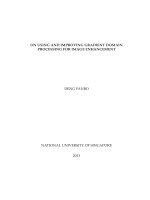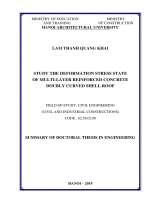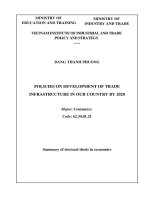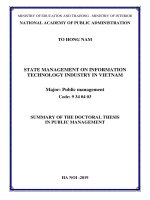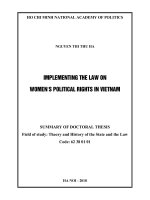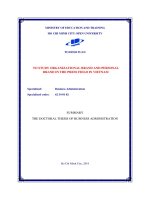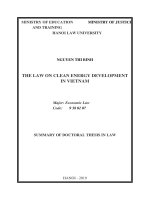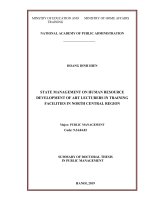Summary of doctoral thesis in physics: Study on design and fabrication of blackbody simulator for image non uniformity correction of long wave infrared (8-12 um) thermal cameras
Bạn đang xem bản rút gọn của tài liệu. Xem và tải ngay bản đầy đủ của tài liệu tại đây (737.87 KB, 14 trang )
MINISTRY OF EDUCATION
AND TRAINING
VIETNAM ACADEMY
OF SCIENCE AND TECHNOLOGY
GRADUATE UNIVERSITY OF SCIENCE AND TECHNOLOGY
……..….***…………
Nguyen Quang Minh
Study on Design and Fabrication of Blackbody Simulator for Image
Non-Uniformity Correction of Long-Wave Infrared (8-12 m) Thermal
Cameras
Major: Optics
Code: 9440110
SUMMARY OF DOCTORAL THESIS IN PHYSICS
Hanoi – 2018
25
The doctoral thesis was completed at Institute of Physics, Graduate University of
Science and Technology, Vietnam Academy of Science and Technology
Supervisors:
1. Prof. Dr. Nguyen Dai Hung
2. Dr. Ta Van Tuan
LIST OF PUBLICATIONS
1. Nguyen Quang Minh, Nguyen Van Thanh, and Nguyen Ba Thi, "Non-Uniformity
of Infrared Imaging Systems using FPA and some Its Correction Techniques," in Hội
nghị Hội nghị Quang học, Quang phổ Toàn quốc lần thứ VII, Session C: Optics,
Laser and Applications, C-24, HCMC, Vietnam, 2012.
2. Nguyen Quang Minh, Ta Van Tuan, and Nguyen Van Binh, "Design
Considerations of a Simple Optical LWIR Imaging System," in Hội nghị Quang học,
Quang phổ Toàn quốc lần thứ VII, Session C: Lasers, Optics and Applications, C-32,
HCMC, Vietnam, 2012.
3. Nguyễn Quang Minh and Tạ Văn Tuân, "Thiết kế ống kính tạo ảnh hồng ngoại xa
cho một camera ảnh nhiệt không làm lạnh," Tạp chí Nghiên cứu khoa học và công
nghệ quân sự, ISSN 1859-1043, (2013) pp. 104-112.
4. Tạ Văn Tuân and Nguyễn Quang Minh, "Phân tích một hệ quang vô tiêu vùng
hồng ngoại xa," Tạp chí Nghiên cứu khoa học và công nghệ quân sự, ISSN 18591403, (2013) pp. 96-103.
Reviewer 1:
..........................................................................
Reviewer 2:
..........................................................................
Reviewer 3:
..........................................................................
This doctoral thesis will be defensed at Graduate University of Science and Technology,
Vietnam Academy of Science and Technology on .....hour....., date .....month.....year.....
5. Nguyen Quang Minh and Ta Van Tuan, "Evaluation of the Emissivity of an
Isothermal Diffuse Cylindro-Inner-Cone Blackbody Simulator Cavity" in
Proceedings of The 3rd Academic Conference on Natural Science for Master and
PhD Students from ASEAN Countries, CASEAN, Phnompenh, Cambodia, (2014) pp.
397-405. ISBN 978-604-913-088-5.
6. Nguyen Quang Minh and Ta Van Tuan, "Design of a Cylinder-Inner-Cone
Blackbody Simulator Cavity based on Absorption of Reflected Radiation Model," in
Proceedings of The 3rd Academic Conference on Natural Science for Master and
PhD Students from Asean Countries, CASEAN, Phnompenh, Cambodia, (2014),
pp.111-121. ISBN 978-604-913-088-5.
7. Ta Van Tuan and Nguyen Quang Minh, "Calculation of Effective Emissivity of
the Conical Base of Isotherrmal Diffuse Cylindrical-Inner-Cone Cavity using
Polynomial Interpolation Technique" Communications in Physics, vol. 26, no. 4, pp.
335-343, (2016). ISSN 0868-3166, Viện Hàn lâm KH&CN VN.
8. Nguyen Quang Minh and Nguyen Van Binh, "Evaluation of Average Directional
Effective Emissivity of Isotherrmal Cylindrical-inner-cone Cavities Using MonteCarlo Method", Communications in Physics, vol.27, no.4, pp.357-367, (2017). ISSN
0868-3166, Viện Hàn lâm KH&CN VN.
This doctoral thesis can be found at:
- Library of the Graduate University of Science and Technology
- National Library of Vietnam
24
1
CONCLUSIONS
From the requirements arising in practice of thermal imaging cameras research
and development in Vietnam, we have chosen the topic " Study on design and
fabrication of blackbody simulator for image non-uniformity correction of long wave infrared (8-12 m) thermal cameras".
The main results and new points of this thesis are:
- The effective emissivity of the diffuse and isothermal cylindrical - inner cone cavity has been calculated using the polynomial interpolation technique for the
angle factor integrals describing the radiation exchange inside the cavity. The
interpolation - calculated results are approximately accurate in comparison with those
obtained by the analytical methods. This approach is a rather new in the practice of
cavity effective emissivity calculation.
- The Monte Carlo radiation absorption simulation algorithm using the 2 dimentional, directional - diffuse surface reflection model has been developed for the
system design of the cylindrical - inner - cone blackbody cavity. It can calculate the
normal effective emissivity of the isothermal cavity with any system parameters. The
developed algorithm is light, simple in computation and helpful in practice of
radiation cavity design.
- The research on system design of the cylindrical - inner - cone cavity has
been implemented using the developed Monte Carlo algorithm. The system
parameters of the cavity have been determined through the simulation - based
optimization method. The simulation - calculated values have been verified by the
polynomial interpolation technique to prove their reliability.
- The blackbody simulator based on the cylindrical - inner- cone cavity with
determined system design has been fabricated. It has been experimentally
characterized to meet all the requirements. This blackbody simulator has been used in
two-point calibration - based image non-uniformity correction (NUC) for thermal
cameras in the room and field conditions.
INTRODUCTION
Thermal imaging cameras based on infrared focal plane arrays (IR FPA) are
increasingly used for day/night electro-optical observation systems. Thermal images
captured by such cameras are generally degraded by fixed pattern noises (FPN). The
most used Non-Uniformity Correction (NUC) technique to minimize the influence of
FPN and improve the infrared image quality of thermal cameras is the linear
calibration using the radiation sources such as blackbody simulators.
The image NUC should be implemented regularly or instantly in field
conditions when required. The blackbody simulators for this purpose are not popular
and generally customized by specific needs. Thus, the topic "Study on design and
fabrication of blackbody simulator for image non-uniformity correction of long-wave
infrared (8-12 m) thermal cameras" is chosen and performed in this thesis to
contribute an effort in solving such practical need. It is a new problem in the research
and development activity of Vietnam.
Purpose of thesis is to research on the efficient calculation methods and the
computational tools usable for designing and fabricating the compact and portable
blackbody simulator based on cylindrical-inner-cone cavity for NUC technique of
LWIR (8-12 m spectral band) thermal cameras in the field conditions.
Research scope of thesis:
- Study on processes of thermal radiation exchange inside real cavity and
cavity radiation characteristics.
- Study on methods of cavity effective emissivity calculation and blackbody
radiation sources characterization.
- Research in development of computational tools and techniques for
calculation of effective emissivity of cylindrical-inner-cone cavity.
- Design and fabrication of blackbody simulator based on cylindrical-innercone cavity. Practical applications of created blackbody in image NUC of thermal
cameras.
Structure of thesis:
Except the introduction and the conclusion parts, the thesis contents of 4
chapters as following:
Chapter 1: Theoretical basics of blackbody radiation.
Chapter 2: Methods of determination of blackbody cavity radiation characteristics.
Chapter 3: Study of calculation of directional effective emissivity of cylindricalinner-cone cavity.
Chapter 4: Research in design, fabrication and characterization of blackbody
simulator based on cylindrical-inner-cone cavity for image non-uniformity correction
of thermal cameras.
Methodology of research: the research in thesis is carried out by theoretical
calculation combined with experimental methods. The main scientific and practical
contributions of thesis are:
Further research direction
- Study of design and fabrication of blackbody simulators for image NUC of
Mid-Wave Infrared (MWIR) thermal cameras.
- Research on development of efficient 2-point calibration NUC algorithm for
thermal cameras developed in Nacentech.
2
23
- Calculation of the effective emissivity of the isothermal diffuse cylindricalinner-cone cavity using polynomial interpolation technique for the integral equations
describing radiation exchanges inside cavity. This approach is almost not found in
published scientific literature concerning blackbody cavity calculation till 2016.
- Calculation of the normal effective emissivity of the isothermal cylindricalinner-cone cavity using self - developed algorithm based on Monte Carlo simulation
of cavity radiation. In this algorithm the interaction of radiation is modelled by a 2 dimensional, directional - diffuse reflectance distribution function of surface. Thus, it
is considerably new contribution in Monte Carlo simulation methods applied in
blackbody cavity system designing.
- Design and fabrication of the blackbody simulator based on cylindrical-innercone cavity working in 8-12 m spectral band. Achievements in this thesis are useful
for image NUC of thermal cameras in room and field conditions and have meaningful
contributions in practice of R&D activity, application and technical service of
thermal cameras developed for special uses in Vietnam.
- The research results of thesis were presented and published in scientific
journals /periodicals and in proceedings of Vietnam and international conferences.
simulator. Suppose that at the temperatures T1 T2 the source emits the radiations
and
. If
were the calibrated grey values of image
pixels, than
and
can be found by solving the system of equations:
CHAPTER 1: THEORETICAL BASICS OF BLACKBODY
RADIATION
1.1. Radiometric quantities
The therrmal radiation emitting by a surface has continuous spectrum and its
energy distribution depends on radiation wavelength and direction [26,28,43]. The
thermal radiation travels in space and interacts with the optical materials in
compliance with the optical laws. The characteristic radiometric quantities such as
radiant power (flux) , radiance L, exitance M, radiant intensity I and irradiance E
are introduced. Among them, the spectral radiance in spherical coordinate system is
defined as follows [26,43-45,47]:
(1.3)
where
is the power emitted by a surface area unit
into a solid angle unit
around the direction , is the radiation wavelength, and
are the angular
coordinates in the spherical coordinate system.
1.2. Radiation absorption, reflection and transmission
Assume that the radiation interacts with the optical material in the thermal
equilibrium conditions. According to the energy conservation law, we have [44,45]:
(1.12)
where
,
,
and
are the radiant powers of irradiation, reflection,
absorption and transmission, respectively;
are the spectral reflectivity,
absorptivity and transmissivity of material , respectively.
1.3. Absolute blackbody radiation
(4.13)
The image affected by FPN at 20C and its grey level histogram are presented
in Fig. 4.29(a) and Fig. 4.30(a). The NUC results are shown in Fig. 4.29(b),
Fig.4.30(b) and in the Table 4.10. The fabricated blackbody simulator also has been
used to perform NUC for the thermal cameras in the field operation, independent of
the weather conditions.
Table 4.10: Evaluation of image non-uniformity (NU)
No
1
2
3
4
5
6
7
Blackbody
temperature TPV (C)
27
25
22
20
18
15
12
Average NU
NU(/mean),(%)
Before NUC
After NUC
28,6
1,9
29,1
1,9
29,8
1,7
30,3
1,5
30,9
1,9
31,7
1,8
32,6
1,9
30,4
1,8
4.6. Conclusions for Chapter 4
The system design parameters of the cavity are determined by the simulation based optimization method through evaluating the distribution of
of the cavity
depending on those parameters. The results obtained by the simulation algorithm are
then evaluated by the polynomial interpolation technique, which shows that their
reliability is satisfactory. The fabricated blackbody simulator consists of the designed
cavity, the TE heat source AC-027 which is controlled by the Yamatake SDC15
temperature controller with the Omron E52-CA1DY temperature sensor.
The experimental results show that the designed and fabricated blackbody
simulator meets all the technical and user requirements. It has been used to perform
NUC for the LWIR thermal cameras in the room conditions with the image NU after
NUC is 1,8% or is 17 times lower than those before NUC. This blackbody simulator
also has been used to perform NUC for thermal cameras in the field, independent of
the weather conditions.
22
3
4.5. Image non-uniformity correction for thermal cameras
The digitalized image pixel value of the thermal camera can be represented by
the linear expression [5,18,20,29,122,123]:
Absolute (perfect) blackbody can absorb all incident electromagnetic radiation
at any temperature, regardless of its wavelength or direction (angle of incidence). The
blackbody radiation is described according to the Plank's law and its spectrum is
determined by the temperature only [26,50]:
(4.10)
where
is the data of position (r,c) of the input image,
are the
multiplicative and additive coefficients, respectively. The image non-uniformity
correction includes the update of the coefficients in the Eq. (4.10) to calibrate the
value
of the output image.
(1.15)
where c1 and c2 are the radiation coefficients,
and
are the blackbody spectral
exitance and radiance at the temperature T. Blackbody radiation also is described by
the Stefan-Boltzmann's and the Wien's laws.
1.4. Blackbody simulator radiation theory
1.4.1. Real body radiation
The radiation capability of real body is characterized by a physical quantity emissivity
. It is defined as the ratio between radiation quantities of real body
at temperature T and those of absolute blackbody at same temperature describing
"blackness" of real body in comparison with absolute one [26,28,47]:
(1.20)
(a)
(b)
Fig. 4.29: The blackbody radiation images at 20C before (a) and after (b) NUC.
(a)
(b)
Fig.4.30: The grey level histograms of the blackbody radiation images at 20C
before (a) and after (b) NUC.
We have set up a model of thermal camera that consists of the IR118 uncooled
module based on 384x288 a-Si microbolometer FPA, the unfocal IR lens [35], the iris
(aperture from 1,0...41,3 mm), and the image-forming IR lens [36]. The image
uniformity of this camera is evaluated by the NU criteria. The video image of IR118
module is captured by the PX610 (Cyber Optics) frame grabber and the grey value of
image pixels can be represented by the linear expression:
(4.12)
The image non-uniformity correction based on two-point calibration technique
for this thermal camera is implemented by exposing the camera to the blackbody
The radiation characteristics of the real body are just approximate of those of
the perfect blackbody at certain temperatures and spectral ranges [51,52].
1.4.2. Blackbody simulator cavity
In practice, there are 2 kind of popular radiation sources: (i) Blackbody
simulators based on cavities, and (ii) Flat plate radiation sources [26,28,30,43,50].
1.4.2.1. Cavity shapes
The radiation of isothermal cavity has the characteristics nearly like those of the
perfect blackbody [26,30,47]. The radiation flux at aperture of the cylindrical-inner-cone
cavity is relatively collimated and distributed similarly to those of the cylindrical one, but
with smaller divergence and higher emissivity. Its uniformity is better than that of the
conical shaped cavity. Even more, the cylindrical-inner-cone cavity can be fabricated in
affordable, lightweight and compact forms, with large aperture and shorten cylinder length
[26,41,53].., that satisfy requirements stated in this thesis.
1.4.2.2. Radiant flux from cavity surface
The outgoing radiant flux from a surface
in the direction (Fig.1.6) has the
spectral radiance
, which can be represented as the sum of the intrinsic surface
radiance
and the radiance of surface reflection portion
[26]:
(1.21)
(1.22)
(1.23)
where
is the intrinsic surface emissivity,
is the surface Bidirectional Reflectance Distribution Function (BRDF) [26,28,54-56],
is the
4
21
perfect blackbody spectral radiance at temperature T,
is the spectral irradiance,
and
are the incident angle and solid angle, respectively. If the cavity surfaces were
diffuse, the irradiation onto the surface
can be represented by the angle factors
describing the solid angles, under which this surface is "seeing" other ones inside the
cavity [26,28,39,40,45,50]. Evidently, radiant flux of cavity surface is always greater
than that of flat radiation source at same conditions (cavity effect) [26,28].
The IT-545 (Horiba) portable infrared thermometer is used to measure the
temperature distribution on 3 areas of the conical surface: around the apex of the cone
(P1), in the middle of the cone (P2) and nearby the base of the cone (P3). As
presented in Table 4.7. the temperature differences between areas are in the range of
0,1C...0,3C and the temperature distribution on the conical surface can be
considered quite uniform. The values TTB are a bit higher than TSV due to the
temperature gradient depending on the thermal conductivity density of the cone. The
differences between them become larger as the temperature offsets of the opposite
surfaces increase. However, these deviations are within the acceptable range ((1K
[16]). As the cylinder of cavity is short enough, so the contribution of its radiation in
the normal directional radiation of the cavity is negligible.
A1
Fig.1.6: Radiant flux of blackbody cavity surface.
1.4.2.3. Effective emissivity of cavity
A blackbody simulator based on cavity is characterized by the effective
emissivity, , that is disimilar to the emissivity of the material, . The local spectral
directional effective emissivity is primary radiation characteristic of the blackbody
simulator that can be defined as [26,28,47]:
(1.25)
where
is the local spectral radiance of surface area unit of cavity at
coordinate
in direction ;
is the spectral radiance of absolute
blackbody at reference temperature .
Other effective quantity such as the total local directional
, local
spectral hemispherical
, and total hemispherical
effective
emissivity can be also defined from Eq.(1.25).
1.4.2.4. Radiation temperature
The cavity radiance temperature is defined as [28]:
Fig.4.22: The spectral radiance of blackbody simulator measured
experimentally.
The radiation characteristics of the fabricated blackbody simulator are
evaluated by using the SR-5000 (CI Systems) spectroradiometer. The output data of
SR-5000 are the values of the spectral radiance
of the measured sample source
(Fig 4.22) at TSV =16, maximum wavelength =10,2 m, corresponding to the
reference temperature of the perfect blackbody T = 290K, max = 10 m. In the
spectral ranges of 5,5m 8,0 m and 12,0 m, the experimental spectral
radiance decreases sharply, possibly related to the absorption caused of water vapor
during the measurements. The average normal effective emissivity of the cavity is
defined as:
(1.30)
Commonly, the term radiation temperature rather than radiance temperature is
used and is defined as follows [28]:
(1.31)
(4.8)
Around the wavelength =10m the effective emissivity is up to 0,999 that
matched with the theoretical calculation result. In the spectral range of
,
is 0,973 that satisfies the requirements
(Table 4.1).
20
5
intrinsic emissivity is ensured by coating the metallic inner walls of the cavity with
the black paint having = 0,90…0,95.
1.4.2.5. Non-isothermal cavity
Real cavity is non-isothermal in nature and its local spectral directional
effective emissivity can be defined as a sum [28,57,58]:
(1.32)
where
is the cavity local spectral directional effective emissivity in isothermal
conditions,
is the non-isothermal addition in total value of the local
spectral directional effective emissivity, which depends on the cavity wall temperature.
Thus, cavity effective emissivity depends on cavity geometry, wall intrinsic
emissivity and temperature. To design a blackbody cavity, one must evaluate its
radiation characteristics in the isothermal conditions firstly.
1.5. Conclusion for Chapter 1
In Chapter 1 an overview of theoretical basics of the thermal radiation, the
perfect blackbody and the blackbody simulator cavity radiation is presented.
Radiation of the blackbody simulator based on cylindrrical - inner - cone cavity
is collimated and uniformly distributed with high emissivity, that is suitable for
thermal camera image NUC.
The outgoing radiant flux of cavity surface consists of the intrinsic emission
and the portion of multiple reflection. Due to this effect, a cavity is characterized by
the effective emissivity. The local spectral directional effective emissivity is primary
radiation characteristic of a cavity. Its value depends on the cavity geometry, wall
emissivity and temperature. At the cavity system design stage, the calculation of the
cavity spectral directional effective emissivity in the isothermal conditions is
necessary. By creating a cavity having the proper geometry and reasonable
temperature distribution, one can get its radiation closely similar to those of perfect
blackbody and usable for practical applications.
Table 4.6: Effective emissivity of radiation cavity (L/R =3; R/r =1,08; = 55)
with various values of .
Wall
emissivity
0,7
0,8
0,9
0,92
e,n calculated by Monte Carlo
simulation (D = 1)
0,971202 (=3,34E-05)
0,9823652(=2,74889E-05)
0,9919636 ((=1,2063E-05)
0.9936954 (=1.05001E-05)
(y0)tb calculated by 2nd order
polynomial interpolation
0,971476
0,982244
0,991752
0,993502
4.3. Heat supply and temperature control
The working temperature of the radiation source is set within the range 1050C corresponding to that the maximum wavelength of cavity radiation should be in
the LWIR spectral range as stated in the technical requirements (Table 4.1). In order
to set the temperature of the inner cone lower than the environmental one, the
thermoelectric (TE) generator based on Peltier effect is chosen. The working
parameters of the TE generator are determined using the finite element method [112]
and the TE Technology AC-027 [114] module with the suitable specifications is used
as the heat supply source. The inner cone temperature is controlled automatically by
using the popular temperature controller (Yamatake SDC15) and the type K
thermocouple (Omron E52-CA1DY).
4.4. Evaluation of characteristics of blackbody simulator
The fabricated blackbody simulator consists of 2 units: 1) The control unit
including the power supply, the SDC15 temperature controller and the control panel;
and 2) The radiation source block including the blackbody cavity, the AC-027 TE
module, the E52-CA1DY temperature sensor, the mechanical construction and outer
cover.
Table 4.7: Temperature distribution of conical surface
TSV (C)
28
26
24
22
20
18
16
14
12
10
TP1 (C)
28,5 (+0,3/-0,1)
26,5 (+0,1/-0,2)
24,5 (+0,1/-0,2)
22,4 (± 0,2)
20,5 (+0/-0,1)
18,7 (± 0,2)
16,7 (+0,2/-0,1)
14,8 (± 0,2)
13,0 (+0,1/-0,2)
11,2 (+0,1/-0,2)
TP2 (C)
28,4 (+0,1/-0,2)
26,5 (+0,1/-0,2)
24,5 (+0,2/-0,1)
22,3 (± 0,2)
20,4 (± 0,2)
18,6 (+0,2/-0,1)
16,6 (± 0,1)
14,7 (+0,3/-0,1)
12,9 (± 0,2)
11,1(± 0,2)
TP3 (C)
28,4 (+0,3/-0,2)
26,4 (± 0,2)
24,3 (± 0,2)
22,3 (± 0,1)
20,4 (± 0,2)
18,5(± 0,2)
16,5 (± 0,2)
14,6 (+0,3/-0,2)
12,7 (± 0,2)
10,9 (+0,1/-0,3)
TTB (C)
28,4
26,5
24,4
22,3
20,4
18,6
16,6
14,7
12,9
11,1
CHAPTER 2: METHODS OF DETERMINATION OF BLACKBODY
CAVITY RADIATION CHARACTERISTICS
The cavity spectral directional effective emissivity can be determined by the
calculation and experimental methods [26,28]. The experimental methods require
complicated equipment and systems for the measurement of the radiation
characteristics of the blackbody simulator [28,63]. The calculation methods are
commonly used in the design stage and also in the characterization of the blackbody
simulator. They are: i) Deterministic calculation methods, and ii) Non-deterministic
calculation
methods
based
on
Monte
Carlo
simulation
[26,28,31,39,40,43,56,60,61,64].
2.1. Deterministic methods
2.1.1. Approximate expressions
The approximate methods are simple and convenient to quickly evaluate the
effective emissivity of a cavity through its geometrical parameters such as: the
aperture diameter, the ratio between aperture and the cavity wall surface areas, the
ratio between cylinder length and aperture radius...as well as through the wall
6
19
radiation properties (intrinsic emissivity and surface reflectivity). Note that the
approximate expressions do not provide exact results and take into account for a few
standard cavity shapes only.
2.1.2. Analytical methods
2.1.2.1. Basic integral equation
In the case of the isothermal - diffuse cavity, the Kirchhoff's law is applied for
its surface radiation characteristics and the thermal radiation exchange between its
surfaces can be described by the integral equations. By solving them, the cavity
effective emissivity can be determined exactly [48]. Following Eq.(1.21), the radiant
flux from surface at position can be defined as [68]:
(2.8)
Assume that the radiation characteristics are temperature and spectral
independent, from Eq.(2.8) we get:
(2.9)
Note that the irradiance
can be represented by the angle factor
Fig.4.5: Distribution of e,n as function of L/R (R/r=1).
:
(2.11)
Replacing Eq.(2.11) into Eq.(2.9), using
(Kirchhoff's law), and
dividing both terms by
(Stefan-Boltzmann law), we have:
(2.13)
In the isothermal conditions, the Eq. (2.13) becomes:
(2.14)
The Eq. (2.14) is referred as the basic equation of the local effective emissivity
of the cavity. It has the form of type II of the Fredholm's integral equation.
2.1.2.2. Equations for effective emissivity of cylindrical-inner-cone cavity
Assume that a cavity is completely closed, totally diffuse and isothermal, then
all its surfaces will emit radiation like that of perfect blackbody with intensity
.
According to De Vos [70], the reflection flux from an area
does not consist
of: i) the irradiation from the aperture
onto it, and ii) the radiation from
reflected by the rest area
of the cavity surface then onto
[60]:
(2.16)
Fig.4.7: Distribution of e,n as function of (L/R=3, R/r = 1).
The cavity parameters must be chosen so as to satisfy the condition e,n ≥ 0,97,
as well as the requirement of cavity compactness. The optimization for cavity
parameters is processed under the considerations:
- As the required aperture is 110mm, the ratio R/r must be not large;
- The value of inner cylinder radius R must be small enough, so that the ratio
L/R is as small as possible;
- The angle must be chosen so as the inner cone mass is as light as possible;
- The intrinsic emissivity should be chosen as high as good.
The cavity system parameters obtained by the optimization are:
The values of e,n of such cavity calculated by the polynomial interpolation and
Monte Carlo simulation techniques have the difference in the range of 10 -4. Note that
the results obtained by the two calculations are equal by rounding them to 10-3 (Table
4.6.). The system parameters listed above satisfy the design requirements. The high
18
7
The system design parameters of the interested cavity
(Fig.3.2)
are determined by the simulation - based optimization technique [107,108]. The selfdeveloped Monte Carlo simulation algorithm is used to investigate the distribution of
depending on
, and . The main criteria used for the optimization
during the simulation are: i) The requirement for compactness of the blackbody
simulator to be designed, and ii) The requirement for the expected value of e,n of this
blackbody cavity.
All of the system parameters should be determined according to the required
value of the aperture radius, r. With the
remained constant, the value of
increases gradually to approximate unity when the
ratio increases and
the largest increase is in the range R/r from 1 to 2 (Fig.4.2). The simulation also
shows that the greater the parameters
or , the higher
value and the
value of
does not depend linearly on .
With the constant value of
and with the certain values of
, the value of
increases when the
ratio increases (Fig.4.5). There are "crtical" values
of
, where
approaches the maximum possible value. The variation of
depends on the ratio
, the angle and the value of . The small value
of
can be established if was an acute angle. The greater value, the the higher
even when small value of
is chosen (Fig.4.5.).
The right term inside the bracket of Eq.(2.16) is the cavity effective emissivity as
defined by Eq.(1.25), where
and
are the angle factors.
y
ds=rdrd
r
O
R0 R 1.0
X = 2R/tan
x
L
Fig. 2.3: Geometry of cylindrical-inner-con cavity [39].
Considering a diffuse and isothermal cylindrical-inner-cone cavity, where
(Fig.2.3), Z.Chu in [39] had rewritten Eq.(2.16) in the terms of the angle
factors and proposed the equations for the distribution of the effective emissivity of
three parts of this cavity. In particular, the equation for the local effective emissivity
of the inner conical base has a form [39]:
(2.17)
Fig.4.2: Distribution of e,n as function of R/r (L/R= 6, = 60).
For each certain set of the cavity geometrical parameters, if the angle is
within the ranges of = 33... 40 or = 50...60 then the value of
was assured
to be highest (Fig.4.7.). Note that the angle > 60 lowers the
in general and
when = 90 the cavity simply becomes a cylinder. In the case of
, the
has a minimum nearby = 45. The function
depends on the parameters
and : the smaller the
, the more e,n dependent on . In contrary, the
larger the
, the less e,nchanges in a wide range of values. The higher ,
the larger e,n .
To solve this equation, one has to derive all of the angle factors
in the Eq.(2.17). It is a difficult and complicated
computational process. The calculation results of Z.Chu [39] show that:
- The cylindrical-inner-cone cavity provides high effective emissivity with
shortened cylinder combined with lower temperature gradient along its length.
- The effective emissivity along the cone base is quite uniform and can
approach unity easily with the practical values of parameters, i.e. for high values of
wall emissivity, small aperture diameter and long cylinder length.
Note that the analytical calculation of the cavity effective emissivity can be
used in the case of non-completely diffuse cavities with difficulties [39,40,56,60,61].
2.2. Monte Carlo simulation method
The Monte Carlo simulation method as the probabilistic treatment of radiation
phenomena can be used in studying on optical radiation processes [73,75,76].
2.2.1. Monte Carlo methods in optical radiometry
2.2.1.1. Stochastic models for surface optical properties
The reflection characteristics of a surface can be modelled by the BRDF as in
Eq.(1.23) which obeys the optical reciprocal principle [57,58,64,68,72,77] and in the
spherical coordinate system (Fig.2.4.) it has the form [28,54,55]:
(2.21)
8
17
In practice, real surface is specular-diffuse rather than perfectly specular or
diffuse [26]. The reflection properties of real surface can be determined by its
roughness [54,77-80] and its BRDF can be represented by the linear combination of
reflection components. In the Uniform Specular-Diffuse (USD) model, the surface
BRDF contains 2 perfect reflection components. This model is most popular in
radiation simulation but remains some disadvantages [21,57,58,81]:
results obtained by our algorithm and by other author using STEEP 3 program from
Virial Inc. in [41] are compared with the differences in the range of 10-4 (Table 3.4).
This means that our algorithm is quite reliable in the design calculation of the
blackbody cavity. The notable advantage of this computational tool is time saving,
visual in calculation and efficient in the practice of designing the blackbody cavity.
3.3. Conclusion for Chapter 3
In this chapter the 2nd - order polynomial interpolation technique is applied for
the angle factors expressions rewritten in the explicit forms to calculate the normal
effective emissivity of the cylindrical-inner-cone cavity. The calculated results are
agreed with those obtained by the numerical analytical methods with the average
differences within the range of 10-4.
The important content of this chapter is the study of development of a
computational algorithm based on the Monte Carlo absorption simulation method for
calculation of the normal effective emissivity of the isothermal cylindrical-inner-cone
cavity. In this algorithm, the corrected simplified Phong's reflection model is used to
describe the directional reflection property of the cavity wall surfaces and the
propagation of radiation inside cavity is simulated on 2-dimenson plane. Such
technique reduces the complexity and the volume of calculation during the ray
tracing process. The results obtained by using this algorithm are agreed with those of
other author [41] with the differences in the range of 10-4.
The techniques studied and developed in this chapter are time - saving,
accurate and reliable. They are quite suitable for the system design of the cylindricalinner-cone cavity in particular and of the blackbody simulator in general.
(2.25)
Recently, the three components (3C BRDF) model as better approximation of
real rough surface is used, but its calculation is more complicated [64,77]:
(2.26)
where
are diffuse, specular, quasi-specular, and ghost reflection
BRDF components.
CHAPTER 4: RESEARCH IN DESIGN, FABRICATION AND
CHARACTERIZATION OF BLACKBODY SIMULATOR BASED ON
CYLINDRICAL-INNER-CONE CAVITY FOR IMAGE NON-UNIFORMITY
CORRECTION OF THERMAL CAMERAS.
Fig.2.4.: Bi-directional Reflectance Distribution Function (BRDF) [77].
specular
component
4.1. Blackbody simulator system requirements
The blackbody simulator to be designed can be used as the standard radiation
source for the thermal image non-uniformity correction. It must be portable in use
and can operate in the field conditions.
Table 4.1: Blackbody simulator system requirements
Fig.2.8: Specular reflection model proposed by Phong [86].
No.
1
2
3
4
5
6
Technical specifications
Cavity geometry
Emission spectral range
Aperture diameter,
Normal effective emissivity
Working temperature
Power supply
4.2. Research in cavity system design
Unit
m
mm
C
VDC
Required
Cylindrical-inner-cone
8-12
110
0,9650,005
10 ...50 ( 1C)
12
16
i
Diffuse
reflection
s
9
g
B.T.Phong (1975) had presented an empirical surface reflection model
(Fig.2.8). Its specular component in Eq.(2.25) is described in the form [83]:
(2.29)
directional
- diffuse
reflection
r
Fig.3.3: The directional - diffuse reflection model [101].
The cavity normal effective absorptivity can be calculated by simulating N
random radiation rays with the initial statistical weights
:
(3.30)
where k = 1,2,...,m is the number of reflections of i-th radiation ray. After k-times of
reflection the statistical weight of a ray,
, will be as :
(3.31)
where
are the surface diffuse and specular
probability density functions, respectively. Consequently, we can obtain the normal
effective emissivity
by using Eq.(3.22). The simulation and investigation of
the radiation propagation in the cavity were implemented using 2 - step inverse ray
tracing technique: i) finding out the intersection points between ray trajectory and
cavity surfaces, and ii) determining the reflection direction of traced ray. The number
of the simulated rays must be large enough (
) to ensure the statistical error
-4
<10 [28,90]. The probability of the reflection events (diffuse or specular) is defined
by the ratio
. The direction of the reflected ray is determined by
the appropriate PDF. The trajectory of the traced ray ended if its statistical weight
after k –times of reflections becomes negligible (
, where is the prespecified uncertainty of calculation) and/or if its trajectory intersects the cavity
aperture. Our simulation algorithm was developed in the LabView environments.
Table 3.4: Average normal effective emissivity for a cylindrical-inner-cone
cavity with L/R = 6, R/r =1, = 60.
Average normal effective emissivity,
Wall
emissivity,
J.Wang results in [41]
Our results
( )
0.7
0.99125
0.991084 ( = 2.62E-05)
0.8
0.99475
0.994903 ( = 1.79E-05)
0.9
0.99757
0.997723 ( = 1.44E-05)
For each set of cavity parameters
, the value of
was
calculated by using our Monte Carlo algorithm and the Eqs. (3.30) and (3.31). The
where
is the ratio between specular reflection portion and irradiation, k models
the beam dimension of quasi-specular reflection and that is chosen to match the
experimental data [54,79,83-85]. The reflection energy depends on the angles of
radiation observation. The Phong's model is very popular in computer graphic
applications because of its simplicity and efficiency. Space and/or angular distribution of
radiation flux can be represented by probability density functions (PDF) with respective
random variables [28].
2.2.1.2. Probability of radiation processes
Based on the conservation law, the interactions between radiation and maters
obey the rule :
as described in Eq.(1.12). In the Monte Carlo
simulation, the values of
are referred to the probability of relevant
phenomena, such as absorption, reflection, or transmission. If in the Eq.(2.25),
, and in the Eq.(2.26),
, so
and
could be used as the probabilities of the reflection components
in the aboved models.
2.2.1.3. Ray tracing
The inverse ray tracing technique is often used in the Monte Carlo radiation
simulation to investigate the radiation propagation trajectories in space and the
radiation interactions with the physical surfaces. At every intersection of radiation
and surfaces, kind of reflection depends on known probability and its direction is
determined by proper BRDF. The ray tracing process is continued until the tracked
trajectory ends.
2.2.1.4. Technique of statistical weight
According to the energy conservation rule, after each interaction with surface,
radiation energy will be partially absorbed and reflected [70]. Supposed that the
initial radiation energy is E, after k times of reflections by a surface having
reflectivity , this energy will become [78]:
(2.34)
if
then
, the initial radiation could be considered completely
absorbed. In the Monte Carlo radiation simulation, a statistical weight
is
assigned to each initial radiation ray, after each reflection
is multiplied by
reflectivity value . This ray is traced and it ends after k -times of reflections if
(where
is small pre-specified uncertainty). Such technique
ensures the convergence of the simulation algorithm.
2.2.2. Calculation of cavity radiation characteristics by Monte Carlo
simulation
2.2.2.1. Emission simulation method
10
15
This method is based on the definition of radiation flux outgoing from a diffuse
surface as in Eq.(1.17), taking into account the number of multiple reflections [89]:
The average values of the effective emissivity of the conical base obtained by
interpolation technique and calculated by other author [39] were introduced in Table
3.3 with the difference within 10-4.
The polynomial interpolation technique is efficient in the calculation of the
effective emissivity of the conical base and can be applied in the cylindrical-innercone cavity design stage despite of requiring certain computational skill [98].
3.2. Study of calculation of normal effective emissivity of cylindrical-innercone cavity using Monte Carlo simulation method
We have proposed the algorithm based on the Monte Carlo radiation
absorption simulation to calculate the normal effective emissivity,
, of the
isothermal cylindrical-inner-cone cavity.
In Fig.3.2, a cylindrical-inner-cone cavity is presented, where L is the cylinder
length, R is the inner radius of cylinder, r is the aperture radius (r
the cavity were specular - diffuse, its emissivity was uniformly everywhere inside the
cavity and independent of spectrum, temperature and radiation direction, so that
. The cavity is considered isothermal and its normal radiation
characteristics obey the Kirchhoff's law and the optical reciprocal rule:
(3.22)
(2.36)
Assume that
and
are the radiation energy emitting by the cavity
surface and outgoing from cavity aperture, respectively [53], we have:
(2.38)
where S is the total area of the cavity internal walls, s is the aperture area, N and Nout
are the total amount of radiation "particles" emitting by S and outgoing through
aperture s, respectively.
This method has advantage in direct calculation of the local effective
emissivity of the non-isothermal cavity. It is helpful in considering heat supply to
have the reasonable temperature distribution inside the cavity. In contrary, this
method requires to determine the distribution functions of each surface. Because of
that, the calculation volume of this method is always large and the computation is
complicated.
2.2.2.2. Absorption simulation method
The cavity effective emissivity
can be defined through its effective
reflectivity
or absorptivity
, taking into account of the Kirchhoff's law
. If cavity had the opaque, grey, diffuse and isothermal surfaces,
we have [53]:
(2.40)
where is cavity wall surface reflectivity, is position of surface unit area, and
are angle factors in nature.
Suppose that there are N "particles" irradiated from aperture and Nk of them
escaped the cavity after k - times reflection, the average hemispherical effective
reflectivity of aperture is defined as [53]:
(2.42)
If there are
particles totally absorbed, the effective emissivity of the cavity
could be found using its effective absorptivity [90]:
y
A(0, R)
C(L,r)
(X’,Y’)
r(,,s)
F(0,-R)
i(,b)
y0
G(R/tan,0)
(0,0)
x
D(L,-r)
E(L,-R)
Fig.3.2: The investigated cylindrical-inner-cone cavity model.
As the cylindrical-inner-cone cavity is rotationally symmetrical, we can
compute its directional effective emissivity in the plane consisting of the initial ray
and all calculation results obtained in this plane are being true for the rest ones of the
cavity [101]. In our work the corrected Phong’s directional diffuse reflection model
was used to approximate the real surface reflectance property (Fig.3.3.)[101]:
(3.27)
(2.45)
The absorption simulation method is simpler and its calculation volume is less
than that in comparison with the emission one. Its disadvantage is that the
temperature distribution information of the cavity is not derived from the calculation.
B(L,R)
where
and
diffuse reflection lobe,
,
characterizes the size of the directional is the surface BRDF.
14
11
Table 3.1: Interpolation polynomials of integral function of d2Fyo,x dFx,ap for a
selection of cavity parameters in the case of =0.7.
2.3. Experimental methods
There are 2 popular experimental methods used for measurement of radiation
characteristics of blackbody simulators using the reflectometers and the radiometers [63].
The temperature distribution of the wall cavity can be measured by the thermometers.
2.4. Conclusion for Chapter 2
The deterministic and the Monte Carlo calculation methods are generally used
in the design stage and in characterizing blackbody cavities. In Chapter 2 the
approximate and analytical calculations of the cavity effective emissivity are
presented as the deterministic methods. The approximate expressions determine the
average values of effective emissivity of the isothermal - diffuse for conventionally
shaped cavity. The analytical method based on the integral equations can precisely
calculate almost all of the radiation characteristics of cavity, where the main
calculation is determination of the angle factors describing radiation exchange
between cavity wall surfaces. Analytical method is difficult to apply for non-diffuse
cavity having complicated shape. The Monte Carlo simulation method is most
flexible that can be applied for calculation of the effective emissivity of the black
body cavity and offers possibilities to investigate radiation characteristics of the
cavity with any geometry and construction. Nevertheless, the deterministic method is
still meaningful in precise calculation of the radiation characteristics of cavity and
provides theoretical arguments for the Monte Carlo simulation method.
The experimental methods used for characterization of blackbody cavity
require high - cost and complicated equipment and systems in laboratory conditions
only. In practice, it is the most reliable means to measure the characteristics of
physical radiation source.
CHAPTER 3: STUDY OF CALCULATION OF DIRECTIONAL EFFECTIVE
EMISSIVITY OF CYLINDRICAL - INNER - CONE CAVITY
The study of calculation of directional effective emissivity of cylindrical-innercone cavity using polynomial interpolation technique and Monte Carlo simulation
algorithm is presented.
3.1. Study of calculation of directional effective emissivity of cylindricalinner-cone cavity using polynomial interpolation technique
Based on the definition of Eq.(1.21) the normal effective emissivity
of
a cylindrical-inner-cone cavity can be evaluated by the local effective emissivity
of the conical base [97,98]. Note that the
will be found by solving the
Eq.(2.17) with the need to determine all of the angle factors in its.
3.1.1. Determination of the angle factors in the equation for the local
effective emissivity of the conical base
In [39], the angle factors of Eq.(2.17) are expressed as follows:
L
R0
8
8
12
12
0,25
0,5
0,25
0,5
30o
60o
20o
45o
0,00020418 (1-y0 tan)2- 0,00057577 (1-y0 tan)+ 0,00054582
- 0,0000502749 (1-y0 tan)2 - 0,000648663 (1-y0 tan) + 0,0017787
0,0000547286 (1-y0 tan)2- 0,000143944 (1-y0 tan) + 0,00013545
0,00001404 (1-y0 tan)2- 0,00018342 (1-y0 tan)+ 0,00044535
Table 3.2: Comparison of the averaged values of first- and second-order terms
of Eq.(2.17) for a selection of cavity parameters( =0.7).
L
R0
8
8
8
8
12
12
12
12
0,25
0,25
0,5
0,5
0,25
0,25
0,5
0,5
30o
60o
20o
60o
20o
30o
30o
60o
Our results
Integrated
Interpolated
0,00054976
0,00086890
0,0016611
0,0034652
0,00016967
0,00023417
0,00093534
0,0015318
0,000549766
0,000868895
0,00166115
0,00346522
0,000169667
0,000234167
0,000935335
0,00153181
Z.Chu[39]
Our results
Z.Chu[39]
0,0006
0,0009
0,0020
0,0035
0,0002
0,0003
0,0010
0,0016
0,00028397
0,000396679
0,0012888
0,00145737
0,0000948923
0,0000941865
0,00029195
0,000375528
0,0003
0,0004
0,0013
0,0015
0,0001
0,0001
0,0003
0,0004
Table 3.3: Average effective emissivity of conical base, (e)ave, of cylindricalinner-cone cavity with surface emissivity = 0.7.
L
R0
8
8
8
8
12
12
12
12
0,25
0,25
0,5
0,5
0,25
0,25
0,5
0,5
30o
60o
20o
60o
20o
30o
30o
60o
Interpolated using 2ndorder polynomial
0,99980951470
0,99970362889
0,99938567800
0,99882927670
0,99994055869
0,99992127221
0,99969312250
0,99950666248
Obtained by Z.Chu's
method[39]
0,999793
0,999694
0,999283
0,998815
0,999931
0,999901
0,999673
0,999484
In Table 3.2, the interpolation- and integration-calculated average values of
dFy0,ap in Eq.(3.5) are almost the same with the difference from 10-7 to 10-8. The
interpolated results of dFyo,ap and of integral of dF2yo,ap dFx,ap seem to be identical with
the ones obtained by Z.Chu [39] with uncertainty within the range of 4.10 -4.
(3.1)
12
13
(3.2)
(3.3)
where the denominators in the Eq. (3.7) are:
(3.8)
where in the Eq.(3.3), the integral limit is a function which has a form:
x ≥ 2/tanθ
1/tanθ
(3.4)
The Eqs. (3.1) - (3.3) can be solved by integrating as stated in [39], but it is
hardly to perform in practice. In our work, we have evaluated these integrals by
implementing the suitable changes or substitutions of variables (See Appendices P.1.P.1.3). The results are obtained as follows [97,98]:
There are the singular points in Eqs. (3.5)- (3.7) where the values of
are
uncertain. They occur when
in Eq.(3.5) and
in Eqs.
(3.6) and (3.7). In our work these sigular points have been treated by applying the
L'Hopital's rule [28,98] (see the Appendix P1.4). Finally we got:
(3.9)
(3.10)
(3.5)
(3.11)
(3.6)
By introducing the Eqs. (3.5) - (3.7) and (3.9) - (3.10) to the `Eq.(2.17) we
have the explicit and simpler form of the equation for distribution of the effective
emissivity of the conical base [97,98]. These newly obtained terms can be calculated
inherently by general numerical integration, although it is still tedious, time wasted
and complicated.
3.1.2. Calculation of local effective emissivity of conical base using
polynomial interpolation technique
The second - order integral terms in Eq.(2.7) have a very complicated forms
although they are represented in the explicit expressions as in Eqs. (3.5) and (3.7). In
our work, if set
to be a continuous function, where
, there was an unique nth-order Newtonian polynomial
[98]:
(3.12)
(3.7)
This polynomial interpolates the approximate values of
between the predefined data points . The order of this polynomial is determined by the interpolation
errors [97.98]. The m = 2 is enough for the required interpolation error < 10-5. The
coefficients
of the polynimial (3.12) are found based on 3 values of
(Table 3.1).
